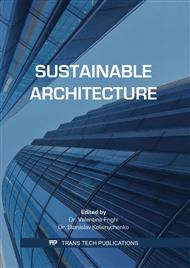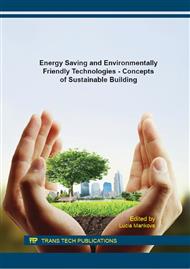p.715
p.724
p.732
p.740
p.751
p.761
p.770
p.779
p.786
Green Building – Towards Sustainable Architecture
Abstract:
The economic activities of man. The increase in the volume of emissions in atmosphere. The rise of global temperature. The biocapacity of the Earth. Ecological footprint. Ecological debt. Renewable sources of energy as a tool for increasing the capital of nature. A united energy market from fossil sources and renewable sources. Transformation of an economy to low energy and low emission technologies for manufacturing and to ecologically clean manufacturing products. The reaction of world science in the field of technology in architecture. Climate defined by physical and chemical parameters. Green architecture. Strategic fields for saving or rational utilization of green buildings – material, energy and water resources. Trends in the application of green building in the field of materials (to ecologically clean materials and the ecological manufacturing of materials), in the field of energy (to ecologically clean resources and ecological energy conversion) and in the field of water (to ecologically clean natural resources and their ecological protection). Sustainable development of society. Green building, process of creating the design and structure of the project ́s strategy. Basic structure of the strategy defining the principles and concepts of green building. Internal structure of the strategy emphasizing the principles and concepts of green building.
Info:
Periodical:
Pages:
751-760
Citation:
Online since:
January 2016
Authors:
Price:
Сopyright:
© 2016 Trans Tech Publications Ltd. All Rights Reserved
Share:
Citation:



